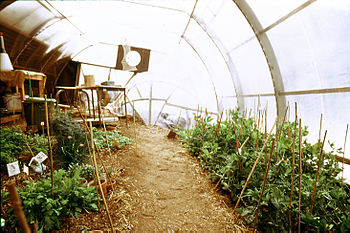 |
| Green power. Footpath near Great Bridgeford. The path follows a green tunnel between the mature hedge and the crop of Miscanthus. Also called Elephant Grass it is grown as a fuel for a mini power station in the area. Eccleshall Biomass Farming for Energy is a 2-megawatt power plant that will generate electricity using energy crops and provides 2,000 homes with electricity. (Photo credit: Wikipedia) |
Is biomass a green energy source? According to experts, yes it is. In fact, it is one of the three main areas of bioenergy.
But what is bioenergy? Well, it is a process by which organic material such as animal waste, plants and wood are used to generate electricity, produce heat and also aid in the production of biofuels.
In the case of biomass, hot air or water is generated to produce electricity. This is done through direct combustion and is considered the simplest and most common method of generating energy from biomass.
Aside from generating electricity, biomass can be used for hot air production so you can keep a place warm. For this to work, biomass has to be combusted in a furnace where it heats either water or air. Speaking of water, this enables you to have warm water so you can take a shower. In short, biomass in itself can also be used on a small scale as a heating system.
Since you can generate electricity and heat, some people have been able to combine the two which is known as combined heat and power or CHP. Something that many consider being good as you use one energy source for two purposes.
If you are able to compare the amount of electricity generated between biomass and let’s say solar energy, you will notice that biomass produces more because the energy in plants is already captured and stored.
You don’t have to collect it first which is what happens with solar or even wind energy since this is manufactured technology. It is readily available unlike the other two which is totally dependent on the weather.
Another is the fact that you can even use organic waste to produce electricity. No other green energy source can do that and by using this extensively, any government can save money because you don’t have to spend money to dispose of the waste and you will no longer depend on foreign oil that much to power your plants.
The downside to biomass is that because you have to burn waste and other organic materials to produce power, you add to the pollution which is already in the atmosphere. But this can be offset of course by planting more crops which we know helps reduce the amount of carbon dioxide in the atmosphere.
You will also have to shell out a lot of money initially for the costs of labor, the transport of these fuels and how these should be stored.
Biomass uses renewable natural resources which is why it is considered a green energy source. This means that we have an endless supply of it around just like the power of the sun or the wind which flows from the ocean. The challenge is to find suitable land that has a sufficient water supply so these will be able to grow.
This means that in areas where water is not that abundant, you cannot rely on biomass technology to generate power. When that happens, you use other means and one good example given the right geographical location is wave energy which is the process of generating power from the water.
There is a way to generate power without causing harm to the environment. We have the technology and green energy sources. We just need to muster the will to make it happen.















